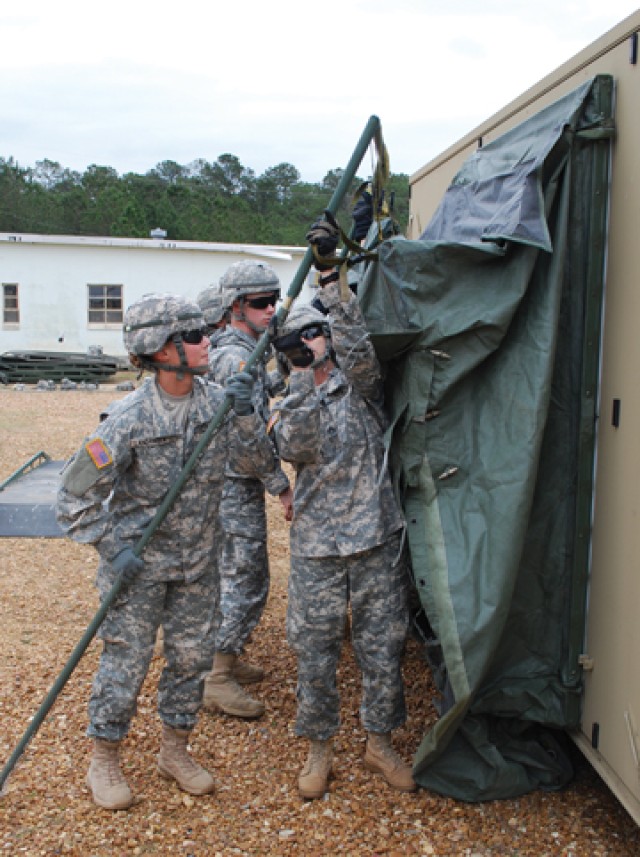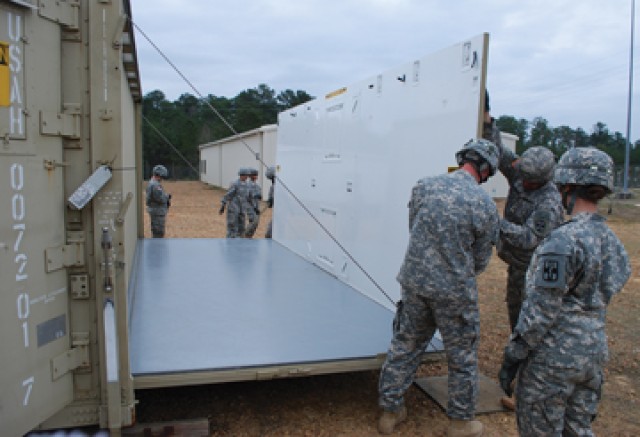FORT POLK, La. (Army News Service, April 2, 2010) -- The 115th Combat Support Hospital will not be caught unprepared for a chemical or biological attack whether an enemy in the field attacks with mustard gas, blister agents or anthrax.
How' The 115th can seal itself off from the outside for 72 hours of self-sufficiency through filters that positively pressurize the mobile hospital air, making it impossible for dangerous gases or pathogens to seep in.
"They call it the balloon," said Sgt. 1st Class Warren Manchester, whose section of the 115th is responsible for the water distribution system for the hospital. This "balloon" transforms the mobile hospital into chemical/biological mode.
One of the major differences between a deployable hospital and a deployable hospital in chemical/biological mode are the latrines. In the normal mode, workers will exit and enter the hospital to use either pit or portable toilets. In the chemical/biological mode, the hospital uses a modularly attached bathroom with flushing water to eliminate the need to send staff outside into a potentially dangerous environment.
Wastewater is sent to an ejection pump that grinds the waste solids into fine particles and sends it to a 10,000-gallon collapsible storage tank called a blivet. Inspecting the chemical/biological latrine, Manchester made sure the freshwater tube stayed above the wastewater tube Aca,!" just in case both contained leaks in the same part of the hose.
Water, like every other resource in the chemical/biological mode, can supply the hospital for 72 hours.
Janet O'Callahan, a project engineer from Natick Soldier Research, Development and Engineering Center, supervised training on the chemical/biological latrine, ejection pump and blivet.
"The initial operational test of this system was back in '97," said O'Callahan about the technology behind the medical system. "All the technology is here, it's just an integration effort, bringing in the right pieces and parts and making sure it all works correctly in training."
The 72 hour-window gives the hospital time to downgrade after being attacked. In this time, the 115th CSH can stabilize and evacuate patients.
The chemical/biological latrine is structurally similar to many of the other sections in the hospital. ItAca,!a,,cs made out of a three-in-one shelter. Collapsed, a three-in-one shelter can fit on the back of a truck. Once folded out, it can provide three times the space.
Specialized modules of the hospital, such as the lab, come with the equipment bolted down in the center area of the three-in-one shelter. Though they can continue to function in case of a chemical or biological threat, the modules are used in the 115th CSH's routine functions.
"When we expand the three-in-ones, we have the same capabilities as a small medical activity laboratory: Basic chemistry, hematology," said Master Sgt. Al Thomas, who oversees the 115th CSH lab. "We have ice machines so we can maintain ice. We do blood cross matches and transfusions, urinalysis and more."
Soldiers of the 115th practiced expanding the three-in-ones March 16 with training instructors from Fort Sam Houston in San Antonio, Texas. Orlando McCarthy, one of the instructors, supervised the Soldiers as they lined up the walls with the ceiling, lifting the wall to the ceiling with hand cranks.
"They are learning how to open it up, pull it up and complex it prior to deployment," said McCarthy. "We're here to train them up on it, make sure they're good to go, and if they have any questions, we're here to answer them."
While some Soldiers trained on raising and connecting the three-in-one isolation shelters others trained on the wastewater system and another group inventoried tents.
"As long as the Soldiers are trained you can get these opened or closed in 15-30 minutes," said Thomas.
"The training takes three days because there's a lot of classroom didactic," said Master Sgt. Dolores Hernandez of the 115th. "They're going to measure stuff, put it on paper, and after they put it on paper, they need to go outside and measure the whole area."
The ultimate goal of the unit is to do a mock chemical/biological exercise beginning April 19 where they simulate an attack to test run the 72-hour CB deployable medical capabilities.
"We haven't been exposed to some of the equipment since it was last deployed," said O'Callahan. "We took this opportunity to refresh ourselves as well as give the 115th a chance to have some hands-on experience with some of the equipment before we go out into the field next month."
(Bryan Gatchell writes for the Fort Polk Guardian.)






Social Sharing